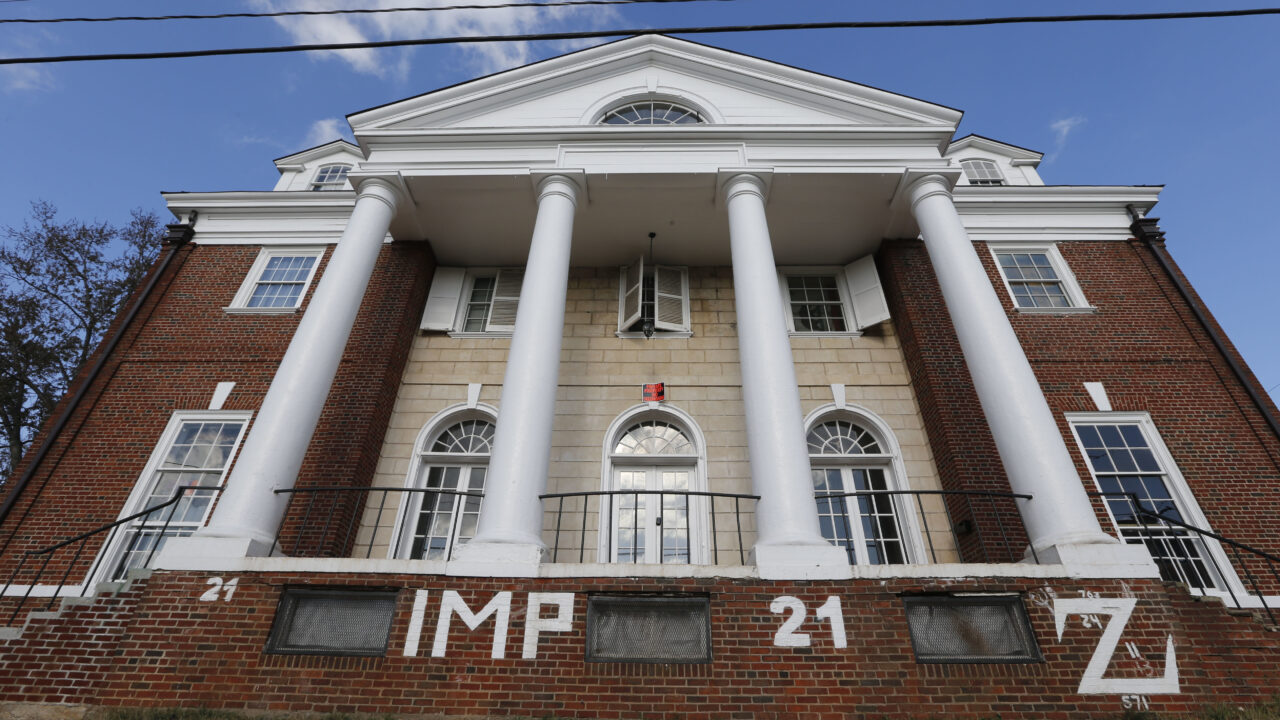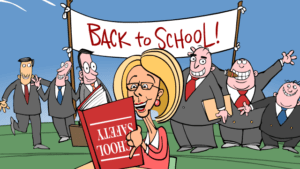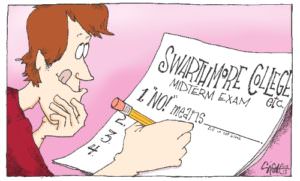The Rolling Stone UVA Hoax Turns 10: A Time Capsule of the 2010s
Behold the collision of real problems, low standards, social media conformity, activist journalism and so much yelling. The Phi Kappa Psi house at the University of Virginia in Charlottesville, Va., as seen on Nov. 24, 2014. (AP Photo/Steve Helber)
The Phi Kappa Psi house at the University of Virginia in Charlottesville, Va., as seen on Nov. 24, 2014. (AP Photo/Steve Helber)
This November will mark the 10-year anniversary of the publication of “A Rape on Campus,” Sabrina Rubin Erdely’s notorious, comprehensively debunked and long-retracted Rolling Stone story. The story recounts the vicious campus rape of a young University of Virginia student named Jackie. Erdely told a lurid tale of a highly coordinated and brutal attack committed by members of a prominent fraternity, then made worse by a callous and unsympathetic administrative response by UVA. The piece created an absolute media firestorm, lighting up social media as thousands upon thousands of people declared that Erdely’s story showed the world we lived in, that our colleges as institutions were indifferent to sexual assault, that we were living in rape culture. It was just the right story at just the right time — a perfect bit of journalism for a time period where the news business was defined by increasing disillusionment with the Barack Obama administration, a resultant rise in radical liberalism, the combination of elite Twitter and its status games, a slowly decaying media industry, and a concerted effort by many journalists to turn their profession into straightforward liberal activism. Rolling Stone and Erdely clearly expected the piece to go mega-viral, and they were proven right.
And then famously, spectacularly and eventually legally, the story was proven to be an utter fabrication. Erdely had failed to do the most basic due diligence required of journalism, and the fantastical narrative told to her by a young woman she should never have believed fell apart in profoundly public fashion. As many, many people said at the time, the controversy badly hindered the national conversation on campus rape, and, oh by the way, it probably wasn’t very chill for the young men who had been falsely accused of the most unspeakable crime imaginable or for the administrators who had been portrayed as indifferent monsters.
What’s remarkable about all of this is that this scenario wasn’t the end of the era of social justice yelling, but a preview of things to come. The culture of fear in media, the groupthink that that culture inspired, the ongoing collapse of a distinction between Twitter diktats and professional requirements in media, the abandonment of any sense that a writer’s job was to do anything other than advance identitarian causes — “A Rape on Campus” was not the sad culmination of all of those things, but a preview of what was to come.
Let’s take a look at the specifics.
As many, many people said at the time, the controversy badly hindered the national conversation on campus rape.
Total credulity toward the right narratives. Many people, over the past decade, have looked back at this story and wondered how the hell the events ever happened the way that they did. Because, like the Jussie Smollett hate-crime hoax that would come a half-decade later, if you can see the details with fresh eyes it seems incredible that anyone ever believed it. The alleged facts alone seem more than sufficient to undermine the credibility of the story.
As Erdely told it, Jackie was deliberately lured to a prominent fraternity house on the night of a big party, where she was attacked by seven pledges (aspiring members of the frat) who were themselves directed by two frat brothers. The pledges threw her onto a glass table, shattering it, before they gang raped her for three hours as a fraternity initiation ritual. When one of the pledges could not maintain an erection, he was directed to penetrate Jackie with a glass bottle. Once they were finished Jackie slipped out of the house unnoticed before eventually calling several friends for help. As you can probably tell, certain questions immediately present themselves. How could a fraternity house maintain the use of gang rape as a ritual initiation practice without inviting the most threatening kind of scrutiny, even given a campus culture that was permissive toward rape? Wouldn’t pledges be even more likely to break the code of silence than full-fledged fraternity brothers? Who would plan a gang rape on the same night as a major party, when the house and grounds would be filled with potential witnesses? Why would anyone throw a woman onto a glass table and rape her among the broken glass, in a planned sexual assault, and risk both cutting themselves in the process and creating more physical evidence of the attack? How was it that a young woman could leave a very crowded party, bleeding from glass and severely traumatized, without attracting any notice?
The first prominent expressions of skepticism towards the story took five full days to appear in print.
I guess I shouldn’t say that these questions immediately present themselves, actually. Because they appear to very much have not presented themselves to the journalist class, our professional skeptics. The first prominent expressions of skepticism toward the story took five full days to appear in print; until the questions became too overwhelming to ignore, many in the profession spent those five days enforcing the consensus and attacking anyone who asked reasonable questions. But more on that below.
A term was thrown around a lot in the aftermath of all of this, a term which does neatly summarize what happened in the initial going: confirmation bias. A profession full of people whose essential job is to ask difficult questions and engage in relentless skepticism of proffered narratives accepted this wildly unlikely story because it confirmed their political priors. This was the era in which the term “rape culture” became ubiquitous, and in particular, college campuses were seen as little sexual assault dens that our society refused to fix.
I think you can acknowledge, as I do, that campus sexual assault and misconduct remain far too common, and uniquely devastating, and still find problems with that narrative. For one thing, I have a political and rhetorical objection to the idea of rape culture, which I think abstracts specific physical acts that are much better dealt with in ruthlessly physical terms. For another, there’s some evidence that the average woman is safer from sexual assault on a college campus than in almost every other part of her life, but of course this was also the era of the ubiquitous claim that one-in-five women are raped during their college years, a statistic that almost no one was going to challenge in 2014. The documentary “The Hunting Ground” came out the following year; it’s just as lurid as its title suggests1. The point being that neither the unbelievable details nor Erdely’s many journalistic failures pushed her peers to disbelieve the story at first, because it reflected their preexisting beliefs back at them.
A culture of fear. The notion that the fabricated story was bad because it set back the effort to combat rape on campus became ubiquitous the moment the debunking became undeniable. (Some diehards really fought like death to avoid the obvious conclusion that the story was bullshit, saying #IBelieveJackie for months or years after the fact.) That is indeed a bad outcome of this scenario. But who was really responsible for that outcome? I’ve said before that during the week when the story was published, I talked to friends — all progressive feminists, some of them women — who were immediately privately skeptical. As would eventually become permissible to say publicly, they pointed out that the story had nothing to do with how most campus rape happens, which usually involves alcohol, a victim and assailant who already know each other socially and scenarios that allow for a “he said, she said” defense. But none of these people were willing to go public with that skepticism, and I wasn’t either. Because, of course, if you had done so before the dam broke, you would have been flayed alive. Perhaps if that had not been true and good feminist people had felt free to voice skepticism, the backlash wouldn’t have been so awful.
Everybody was afraid to speak out of turn. Being publicly screamed at by your peers for several days is unpleasant.
It’s really genuinely difficult for me to imagine a culture less conducive to free inquiry, controversial opinions and uncomfortable truths than that which has governed media in the past decade or two. You had an elite media that was dominantly made up of left-of-center and Democratic voices, with a steering committee of that elite class that was even further left-leaning. You had a crumbling media job market, which created a profound sense that getting everyone else in the industry to like you (or at least not actively dislike you) was essential for remaining employable. And you had Twitter, which made all of this public, had direct quantitative indicators of which opinions were popular and which weren’t, created a permanent record, and allowed for periodic communal charivaris that demonstrated the crowd’s ability to inflict punishment. A lot of people like to minimize this aspect, saying that you didn’t have to be on Twitter, but in fact the notion that you had to have an active Twitter presence to build a durable media career was omnipresent in that era. (It was often the first thing veteran journos told college students about the business.) And so, yeah, of course it took five days for the whole house of cards to fall down, and it’s not a coincidence that it was people mostly aligned with the broad right wing who started asking the first public questions. Everybody was afraid to speak out of turn. Being publicly screamed at by your peers for several days is unpleasant.
Social justice as the sole meaningful purpose of journalism. Not a lot needs to be said about this one. At some point, contributing to (a particular and strange Ivy League definition of) social justice came to be seen by many in the industry as the primary purpose of journalism and commentary. The abstract ideals of impartiality and truth are the kind of thing that are least likely to survive an environment that combines social conformity with limitless sarcasm. What struck me about this era was not that so many in the business just uncomplicatedly assumed that their job was to fight for social justice but how many didn’t see any reason why they would hide that fact.
After initially sticking by her story, Erdely finally caved and admitted fault, but did not direct any specific apology to the members of the fraternity house in question.
Owned enough to apologize, but not to apologize to fraternity boys. One of the incredible things about the whole controversy was that, after all of the publicity and all of the media attention and all of the recriminations and all of the soul-searching, very little ever happened in terms of apologies to the falsely accused themselves. After initially sticking by her story, Erdely finally caved and admitted fault, but did not direct any specific apology to the members of the fraternity house in question. The frat house got a settlement, the specific UVA administrator that Erdely nominated as the face of evil for the story got a settlement, there was a Columbia J-school investigation, there was a criminal investigation, there was a lot of blowback, but there wasn’t much at all in terms of saying “Hey, sorry we all immediately believed that you engaged in ritualistic gang rape, Phi Kappa Psi! Whoops!”
Because of the nature of the modern internet, it was easy for people to look up the specific personal details of members of the fraternity, and a lot of them did, engaging in the kind of internet harassment that we’re very quick to denounce when its directed against the right kind of victim. As you’d expect, the members of the fraternity, now widely believed to be involved in orchestrating gang rape, faced a great deal of personal consequences for a made-up story that they had never been given a chance to rebut. UVA, showing the backbone typical of modern academia, immediately caved and shut down all Greek organizations, despite the fact that Erdely had not even attempted to interview the accused. Many prominent members of the university community denounced them. There were a lot of negative repercussions for guys who did quite literally nothing wrong. And yet widespread public contrition on their behalf never emerged, and I suspect the reason why is obvious: white southern frat guys were not the kind of people that media liberals were ever likely to feel sympathy for. Those who raged out for five days about a priors-confirming fabulist tale may have been owned, but they weren’t going to be owned into the position of feeling bad for the kinds of guys their culture insisted we should never feel bad for.
Slate’s Hanna Rosin wrote at the time, “In the last few days, the names of the fraternity members started to leak out, and many of us began to look up their Facebook pages. I found myself playing the profiling game: Is that the kind of haircut a rapist would have? Are those the kinds of girls he would have hanging all over him? Oh, yeah, that bro is totally a rapist.”
Whoops!
Real problems, not solved. Of course sexual assault is a major social issue, a particularly cruel and destructive crime, and one we need to fight vigorously. And while the actual relative prevalence of sexual assault on campus compared to other places seems undiscovered, to me, that’s no reason not to want to mount an effective campaign against the problem. The issue is not just that the Rolling Stone story did nothing to help and probably a fair amount to hurt. It’s that the broader cultural practices that produced the story — the reflexive assumption that anyone accused is necessarily guilty, treating reasonable questions as if they imply that the questioner condones sexual assault, dismissing past experience of false accusations as rape culture, acting as though seeking the actual truth is a way to “revictimize” survivors, and giving a screamer’s veto to anyone who lashes out the most violently — themselves hurt our ability to respond rationally and effectively to our ongoing problems with sexual assault.
It’s similar with my criticisms of affirmative consent: setting aside all concerns with rights of the accused, policies based on an affirmative consent standard don’t even help address the problems reformers want to address. (You can read the linked piece, but the fundamental point is that affirmative consent does nothing to change the “he said, she said” legal issue that makes punishing sexual assault so difficult.) There, too, debate collapses immediately along typical culture war lines, with most people on the left dutifully lining up in support of affirmative consent, despite the fact that the logic of the policy collapses when subject to a little rigorous examination. But … why? If the policy doesn’t work, then people who purport to care the most about sexual assault have no reason to support it! Similarly, the Rolling Stone case presaged broader liberal attitudes toward these issues, an attitude that presumes that the best way to support victims is to engage in the angriest histrionics, with screaming the loudest being the best method to show you really care. Most people get onboard with the establishment narrative for fear of running afoul of that screaming. That has not made it any easier to effectively address sexual assault, not for anyone.
Policies based on an affirmative consent standard don’t even help address the problems reformers want to address.
But yelling the loudest remains something like the default liberal response to certain highly emotional issues even to this day. As I said above, Erdely’s folly was the epitome of how the combination of liberal self-righteousness and a brutally retributive media professional-social culture can create a climate of fear that prevents anyone from asking hard questions — and yet this all happened nearer to the beginning of the yelling social justice era than to the end. In some ways I think this whole imbroglio demonstrated the strength of that kind of culture rather than weakness; all of this embarrassment was entirely insufficient to compel people to ask whether there wasn’t something deeply unhealthy going on in media, particularly regarding the way that Twitter had become a powerful censor. Jezebel ran one of the most glib and insulting of the many pieces that defended the consensus view on the story, and yet not only did it not back away from its trademark brand of sneering righteousness, it doubled down on it. When the next controversy rolled around the people who had righteously screamed that they believed Jackie just went right back to righteous screaming. The tools used to enforce a very provincial and shortsighted worldview, among paid-up NYC media types, emerged from this whole fiasco unscathed. And it’s only recently, perhaps, that they have ceased to rule.
- “The Hunting Grounds” also directly implicates a Black Harvard Law student of sexual assault despite the fact that he was cleared of any wrongdoing by both Harvard and the local police, which is one of those little facts that underlines the strange historical reality that the era of carceral feminism overlapped with the racial justice era of police and prison abolition. ↩︎
Independent journalism is under threat and overshadowed by heavily funded mainstream media.
You can help level the playing field. Become a member.
Your tax-deductible contribution keeps us digging beneath the headlines to give you thought-provoking, investigative reporting and analysis that unearths what's really happening- without compromise.
Give today to support our courageous, independent journalists.





You need to be a supporter to comment.
There are currently no responses to this article.
Be the first to respond.